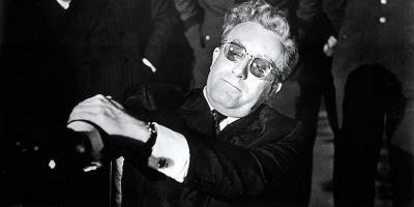"Bomba Tsar - Fine del Mondo"
Teramo | La più potente mai costruita, 3.800 volte più distruttiva della nucleare di Hiroshima, il 30 ottobre 1961, l'onda d'urto fece il giro della Terra tre volte, lo shock termico colpì a 270 km dall'epicentro, lo shock sismico risultò misurabile al terzo giro.
di Nicola Facciolini

Bomba Tsar Fine del Mondo
Cosa fareste, se vi dicessero che vi restano solo pochi minuti di vita, per l'imminente fine del mondo? "Il dottor Stranamore, ovvero: come imparai a non preoccuparmi e ad amare la bomba", il film capolavoro di Stanley Kubrick del 1964, ci ha insegnato a temerla. Quel giorno, abbacinante e glaciale del 30 ottobre 1961 quando esplose veramente, fu definito "il giorno in cui la Terra fu uccisa". La "Bomba Tsar - Fine del Mondo" è realmente esistita ed è stata il più potente ordigno termonucleare (all'idrogeno) mai sperimentato dall'uomo sulla Terra. Fu costruito in Unione Sovietica nel 1961, su comando del Pcus, da un gruppo di lavoro capeggiato da militari e dal fisico Andrej Dmitrievič Sakharov, in poco più di 15 settimane.
Il nome in codice dell'ordigno era Big Ivan. Al confronto, tutti gli altri esperimenti termonucleari effettuati delle altre potenze negli anni ‘60, sembrano mingherlini! Il potere esplosivo della bomba Tsar fu di 57 megatoni circa (altre fonti affermano, fra i 62 e i 90 megatoni), ovvero oltre 3.800 volte quello della bomba nucleare sganciata su Hiroshima. È stato calcolato che se fosse stata lanciata su Londra, la Tsar avrebbe distrutto ogni cosa nel raggio di 30 km e incendiato tutto ciò che si fosse trovato entro 90 km dal luogo dell'esplosione.
Inizialmente si pensava di realizzarla con una potenza di 100 megatoni ma, per evitare di "bucare" l'atmosfera terrestre (e non solo per un eccessivo fallout nucleare) fu poi ridimensionata a 57 megatoni. La bomba fu sganciata il 30 ottobre 1961 alle ore UTC 8:32 (11:32 ora di Mosca) da un aereo ad alta quota (un Tupolev 95, il pilota del quale divenne poi eroe nazionale) nella baia di Mityushikha, sull'isola di Novaja Zemlja, a nord del Circolo Polare Artico, precisamente alle coordinate 73.85° Nord e 54.50° Est.
La Tsar fu fatta esplodere a 4mila metri dal suolo con l'ausilio di un gigantesco paracadute per frenarne la caduta e quindi consentire al velivolo di allontanarsi indenne. La sfera di fuoco nucleare fu di 4,6 Km e la nube a fungo risultante dall'esplosione raggiunse un'altezza di 60 km mentre l'onda d'urto fece tre volte il giro del mondo impiegando per il primo "circuito" 36 ore e 27 minuti). Ci fu anche un black-out delle comunicazioni radio in tutto l'emisfero settentrionale. Tuttavia, contrariamente a quanto si può pensare, quella della Tsar fu un'esplosione "molto pulita" ed efficiente in quanto trasse oltre il 97% della sua potenza dalla fusione termonucleare. Tale test fu preceduto il 9 agosto 1961 dalla dichiarazione di Khruscev nella quale affermava che l'Unione delle Repubbliche Socialiste Sovietiche era in grado di costruire e intendeva sperimentare una superbomba da 100 megatoni, scatenando forti proteste internazionali.
A tali dichiarazioni seguirono il 16 gennaio 1963 le rivelazioni fatte a Berlino Est, sempre dallo stesso Khruscev, del possesso di una bomba di quel tipo da parte dell'Unione Sovietica. Un simile ordigno, se testato sulla superficie terrestre, aprirebbe nella roccia un cratere profondo oltre 100 metri e largo quasi 3 km, con un "fungo" di 14 km di diametro. In realtà si è calcolato che l'esplosione fu di circa 50 megatoni (circa 2.1×10 alla 17ma potenza in joule oppure 5.3×10 alla 24ma potenza in watt), quasi 4mila volte più potente delle bombe sganciate dagli Usa su Hiroshima e Nagasaki il 6 e il 9 agosto 1945.
La riduzione di potenza della Tsar si ebbe perchè dal progetto iniziale di bomba a tre stadi (fissione-fusione-fissione) si passò ad una bi-stadio (fissione-fusione), sostituendo il terzo stadio di uranio con uno di piombo. Ciò ridusse enormemente il fallout radioattivo visto che il 97% dell'energia liberata fu derivata dalla fusione e solo il 3% dalla fissione. Big Ivan fu definito il test nucleare più pulito mai effettuato sulla Terra. Se invece fosse stata esplosa come una bomba da 100 megatoni, questo avrebbe potuto aumentare il fallout radioattivo di tutti i test mai effettuati sulla Terra del 25 %. La bomba sovietica Tsar pesava 27 tonnellate, era lunga 8 metri e aveva un diametro di 2 metri. Fu sganciata con un paracadute dalla quota di 10.500 metri. La bomba esplose a circa 4mila metri d'altitudine, il lampo termonucleare fu visibile a mille chilometri di distanza.
L'onda d'urto fece il giro della Terra tre volte e lo shock sismico era ancora misurabile al terzo giro del globo. Per circa un'ora ci fu un blackout completo delle comunicazioni, il fungo atomico salì per 60 Km nell'atmosfera e nel raggio di centinaia di chilometri furono bruciate tutte le case di legno, mentre gli effetti termici si avvertirono sino a 270 Km di distanza con ustioni di terzo grado. Solo una speciale vernice termoisolante permise al Tupolev 95, il quale al momento dell'esplosione si trovava già a 45 Km di distanza, di non esplodere a causa dell'effetto termico.
La bomba in realtà non aveva alcun scopo militare, visto che un ordigno di tale potenza non aveva specifici usi tattici. Fu sperimentata solo come azione dimostrativa delle capacità tecnologiche dell'allora impero sovietico e del suo leader Nikita Kruscev. La bomba non aveva impieghi pratici visto che era troppo pesante per essere trasportata da un missile balistico e inoltre un aereo che avesse voluto sganciarla su una città del nemico sarebbe stato facilmente abbattuto prima ancora di violare lo spazio aereo nemico. I "figli" della Tsar Bomba furono le testate Mirv dei missili balistici intercontinentali (Icbm). Andrej Dmitrievič Sakharov, fu poi insignito del Premio Nobel per la Pace. L'atomica non esiste: difficile, molto difficile disimparare la tecnologia della bomba Tsar e di qualunque altra termonucleare o nucleare.
"Tsar Bomba, the King of Bombs".
On October 30, 1961, the most powerful weapon ever constructed by mankind was exploded over the island of Novaya Zemlya in the Arctic Sea. The device was code-named "Ivan," and it was a multi-stage hydrogen bomb which was built in only fifteen weeks by engineers in the USSR, using off-the-shelf nuclear weapon components. It was intended as a display of Soviet superiority during a period of grave tension between the USSR and the United States.
The Russians had erected the Berlin wall only two months earlier, and they had just ended a shaky, three-year moratorium on atmospheric nuclear weapons testing. Before Ivan, the largest explosion the world had seen was an incredible 15 megatons, an event which caused a mushroom cloud five kilometers across. Ivan's explosion was over three times more powerful, despite the fact that the device was deliberately prevented from operating to its full potential.
The completed weapon weighed 27 metric tons, and though it was technically "aircraft-deliverable," it was too large to fit inside the bomb bay of the largest soviet bomber of that era, the Tu-95. Consequently, a Tu-95 was specially modified for the task, including the removal of the bomb bay doors to allow the bomb to protrude from the plane, and a coating of a special reflective paint to minimize the heat damage it would sustain from the fireball.
Ivan was also attached to a parachute to prevent it from descending too rapidly, thereby giving the bomber adequate time to get out of range of the blast. Because the project had been rushed, much of the mathematical analysis was skipped, and estimations were used instead. This led to uncertainties about the system performance, and last-minute design modifications. Doubts and uncertainties notwithstanding, on October 30, 1961 the Tu-95 dropped Ivan from an altitude of 34,500 feet over the Mityushikha Bay Nuclear Testing Range at Novaya Zemlya. The weapon's on-board barometric sensors detonated the bomb at approximately 13,000 feet at 11:32am.
Despite the cloudy weather, the flash of light was visible as far as 1,000 kilometers distant, though the sound of the blast would not reach that far for forty-nine minutes, in the form of an indistinct, heavy blow. The giant fireball reached from ground-level to about 34,000 feet into the air, violently releasing 3800 times more explosive energy than the Hiroshima bomb- equivalent to fifty million metric tons of TNT. One hundred kilometers from ground zero the heat would have inflicted third degree burns. Atmospheric focusing produced areas of destruction hundreds of kilometers from ground zero, including wooden structures which were completely destroyed, and some shattered windows in Finland.
The explosion's atmospheric shockwave traveled around the Earth three times before it dissipated. The mushroom cloud which followed the blast was enormous in scale. It stretched sixty kilometers into the sky, and had a diameter of about forty kilometers. Ionization from the explosion disrupted radio communications for the better part of an hour. Some time after the explosion, a team was dispatched to ground zero to take photographs.
One witness reported: "The ground surface of the island has been levelled, swept and licked so that it looks like a skating rink. The same goes for rocks. The snow has melted and their sides and edges are shiny. There is not a trace of unevenness in the ground... Everything in this area has been swept clean, scoured, melted and blown away." Analysis of the explosion showed that the area of complete destruction had a radius of twenty-five kilometers from ground zero. Naturally, the United States was outraged, and responded by rattling its nuclear sabre in return. The U.S. soon followed suit with an extensive series of nuclear weapons tests. Ivan- sometimes referred to as "Tsar Bomba" or "King of Bombs"- was originally designed to yield a 100 megaton explosion, but the soviets decided that such a blast would create too great a risk of nuclear fallout, and an almost certain chance that the release plane would be unable to reach safety before detonation. Prior to testing, the engineers replaced a portion of the radioactive uranium with a lead tamper, cutting its explosive potential in half, to a "mere" 50 megatons.
Later analysis showed that the fallout from a 100 megaton detonation would have resulted in lethal levels of radioactive fallout over an enormous area. Even at half strength, Ivan was so powerful that it was completely impractical. Much of the explosion's energy radiated upwards into space, and that which didn't was so excessive that using the device on any populated targets world would have resulted in adverse effects on Russian interests. It served as nothing more than a show of force, and in that respect, it served its purpose well. Thankfully, no other weapon with the massive destructive power of Tsar Bomba has ever been built.
Video Tsar Bomb:
Http://www.videocaffe.com/video/NiyUSv2Z07A/Tsar-Bomba---The-King-of-Bombs
Fonti: Wikipedia; Vce.com; nuclearweaponarchive.org
|
|
24/09/2007





Altri articoli di...
Teramo e provincia
Una serata di emozioni e scoperte (segue)
“Cin Cin”: a tavola con i vini naturali (segue)
L’opera di Enrico Maria Marcelli edita dall’Arsenio Edizioni ha vinto il Premio Quasimodo (segue)
A Martinsicuro “Natale con le tradizioni” (segue)
Doppio appuntamento per “Sentimentál” di Roberto Michilli (segue)
Roberto Michilli presenta il 16 novembre a Campli “Sentimentál” (segue)
Parte sabato 26 ottobre a Giulianova la rassegna “La pintìca dei libri” (segue)
Il 28 luglio la premiazione dei vincitori del Premio Letterario “Città di Martinsicuro” (segue)
Le strade musicali dell'Ebraismo nel compendio cinematografico di David Krakauer

Una serata di emozioni e scoperte

Betto Liberati







